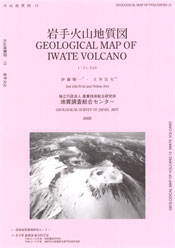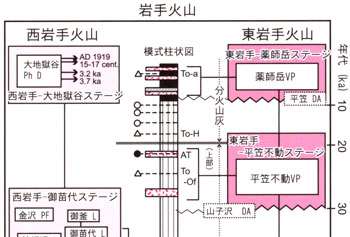Iwate Volcano
1: Introduction / 2: Geology of Iwate Volcano / 3: Outline of Iwate Volcano
4: Eruption history of Iwate Volcano
5: Eruptions of historical times / 6: Latest activities
7: Monitoring of volcanic activities / 8: Points to be watched for mitigation of disaster
Acknowledgment / References
![]() PREV
PREV ![]() NEXT
NEXT
1: Introduction / 2: Geology of Iwate Volcano / 3: Outline of Iwate Volcano
1: Introduction
Iwate Volcano is an active volcano situated about 18 km north of Iwate City with three known records of eruptions even for the limited time span since Edo period. From March 1998 seismic activity became vigorous with crustal deformations suggesting underground movement of magma. It didn't lead to eruption, however.
This volcanic geologic map is a compilation of geology and eruptive history of Iwate Volcano. We sincerely hope that the map is utilized for the future geologic studies, prediction of eruption, mitigation of disaster, and education. Because of limited space, sources of information were not individually cited in the text but shown at the end of the text as references.
2: Geology of Iwate Volcano
Matsukawa andesites, Amihari volcanic group, and Iwate Volcano were grown since about 1.8 m.y.BP ( early Pleistocene ) on the basement of the rocks consisting of Miocene Iioka Formation, Pliocene Mitsumoriyama andesite, and late Pliocene to early Pleistocene Tamagawa welded tuff. Among them, Matsukawa andesites consist of andesitic lavas and pyroclastic rocks, all of which have suffered strong hydrothermal alterations, and show no clear volcanic topography. Amihari volcanic group is distributed from Mitsuishiyama ( outside of map area ) to Kurakakeyama over 12 km with gentle topographic features, and consists of andesitic-basaltic rocks. Based on the degrees of preserved topographic features, it is classified into two stages, early and late. In the early stage, small independent stratovolcanoes were formed, while in the late stage explosive activities were characteristic with formation of craters from which andesite lava flows spilled later. Original topography of late stage lava flows is comparatively well preserved and part of lava flows overlies Nishi-Iwate Volcano ( described later ). On ridges, normal faults are well developed extending in east-west direction. Especially, graben-like topography is recognized from Kurokurayama to Inukurayama. In the northwest side of map area are distributed early to middle Pleistocene Hachimantai volcanic ejecta, which are presumed to be the source of Matsuo debris avalanche deposits distributed on the upstream area of Matsukawa River.
3: Outline of Iwate Volcano
Iwate Volcano is a large stratovolcano consisting mainly of basalt and andesite. At least six large collapses and rebuildings occurred repeatedly during last 300,000 years. Iwate Volcano is divided into two parts; conical Higashi-Iwate Volcano with the highest peak of Yakushidake ( 2,038 m a.s.l. ) in the east and Nishi - Iwate Volcano with Nishi-Iwate caldera ( its size being 2.5 km east-west and 1.5 km north-south ) on the summit. For each volcano, multiple eruptive phases are discriminated being separated by dormant intervals lasting about 10 thousand to hundred thousand years.
Eruptive activities of Iwate Volcano began from Nishi-Iwate Volcano 300,000 yBP, at first as a stratovolcano ( which consisted of Nishi - Iwate - Onigajo stage and Nishi - Iwate - Omisaka stage with intervening dormant period spanning about 20,000 years ) followed by Nishi-Iwate caldera on the summit. Within the caldera a group of central cones was formed ( Nishi - Iwate - Onashiro stage ) followed by fumarolic and geothermal activity stage that continues to this day ( Nishi - Iwate - Oojigokudani stage ). On the other hand, after the large collapse of the mountain body, Higashi-Iwate Volcano repeated mountain-building activity cycles three times, each of which consisted of 10,000 to 20,000 years' eruptions followed by dormant periods. These are named Higashi - Iwate - Onimata stage, Higashi - Iwate - Hirakasafudo stage, and Higashi - Iwate - Yakushidake stage, respectively, in ascending order. Eruptive stages of Nishi - Iwate and Higashi - Iwate Volcanoes were in part taken turns or in part overlapped ( ![]() Fig. 1 ).
Fig. 1 ).
Modes of eruptions of Iwate Volcano have been variable; Eruptions of ash, pyroclastic surges, pyroclastic flows, lava flows, and formations of pyroclastic cones. During last 7,000 years, magmatic eruption in Higashi-Iwate while phreatic eruption in Nishi-Iwate were prevailed. Some eruptions seem to be interconnected between Higashi- and Nishi-Iwate Volcanoes.
Rocks and ejecta of Iwate Volcano are mostly andesite-dacite of tholeiitic rock series. However, andesite-dacite of calc-alkali rock series also occur ( such as in Nishi - Iwate - Omisaka and - Onashiro stages ) though limited in time and space. On the other hand, rocks of tholeiitic series in Nishi-Iwate Volcano consistently show higher K2O than those in Higashi - Iwate ( ![]() Table 1 ).
Table 1 ).
![]() PREV
PREV ![]() NEXT
NEXT


 ZOOM
ZOOM